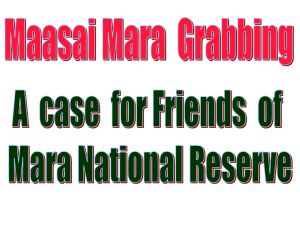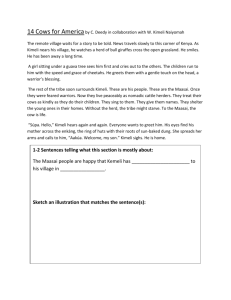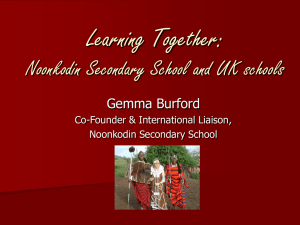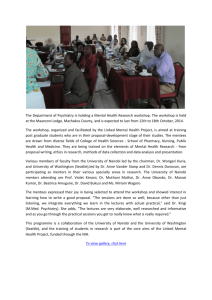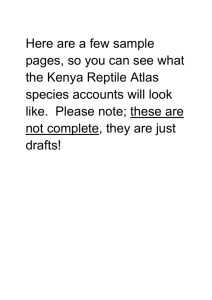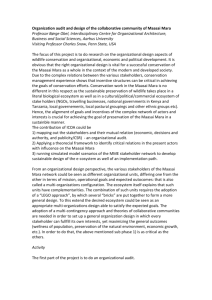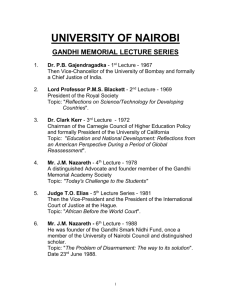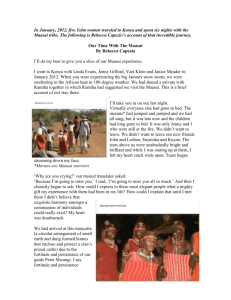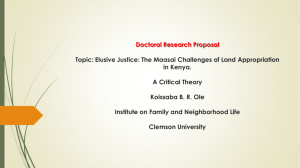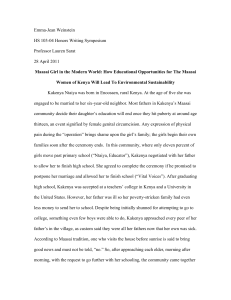Teacher`s Notes – Section 4 Key Question: How is life changing for
advertisement
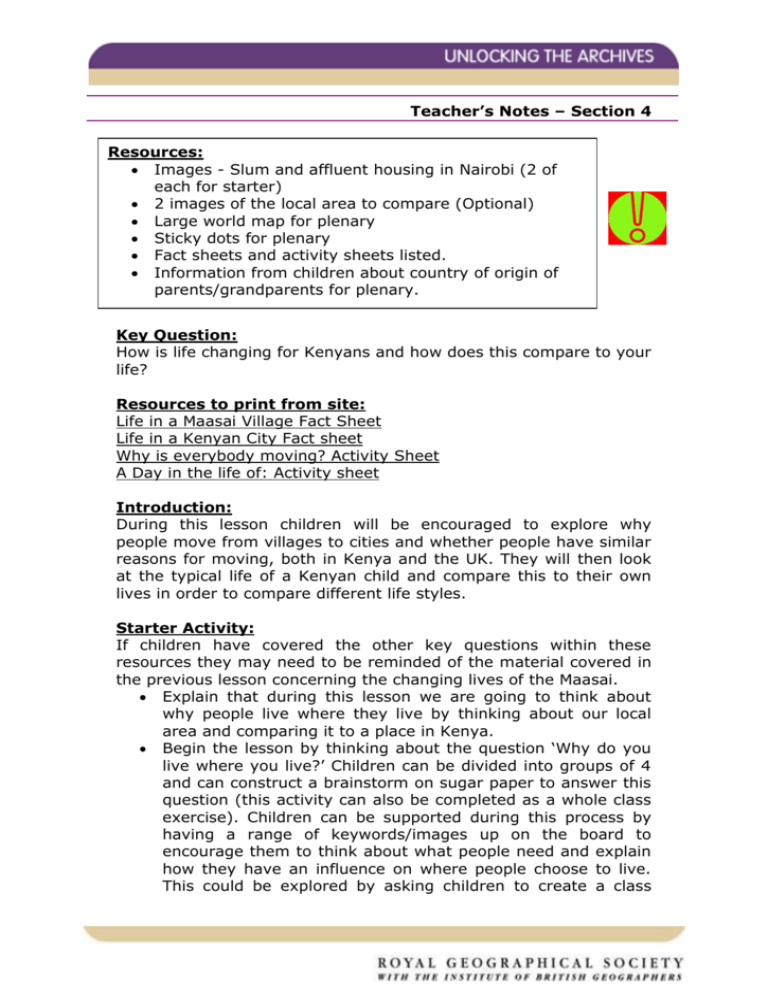
Teacher’s Notes – Section 4 Resources: Images - Slum and affluent housing in Nairobi (2 of each for starter) 2 images of the local area to compare (Optional) Large world map for plenary Sticky dots for plenary Fact sheets and activity sheets listed. Information from children about country of origin of parents/grandparents for plenary. Key Question: How is life changing for Kenyans and how does this compare to your life? Resources to print from site: Life in a Maasai Village Fact Sheet Life in a Kenyan City Fact sheet Why is everybody moving? Activity Sheet A Day in the life of: Activity sheet Introduction: During this lesson children will be encouraged to explore why people move from villages to cities and whether people have similar reasons for moving, both in Kenya and the UK. They will then look at the typical life of a Kenyan child and compare this to their own lives in order to compare different life styles. Starter Activity: If children have covered the other key questions within these resources they may need to be reminded of the material covered in the previous lesson concerning the changing lives of the Maasai. Explain that during this lesson we are going to think about why people live where they live by thinking about our local area and comparing it to a place in Kenya. Begin the lesson by thinking about the question ‘Why do you live where you live?’ Children can be divided into groups of 4 and can construct a brainstorm on sugar paper to answer this question (this activity can also be completed as a whole class exercise). Children can be supported during this process by having a range of keywords/images up on the board to encourage them to think about what people need and explain how they have an influence on where people choose to live. This could be explored by asking children to create a class listing of the things they and their families do every week (for example: shopping for food, going swimming, going to school, going to work, visiting the doctor, going to the park, visiting family etc). This listing can be used as the basis for later discussion of the reasons behind why people live where they live. Key words are provided in the box below: Money Education Jobs Safety Family Location Services Climate Children can then be invited to share their ideas in order to build up a colourful class brainstorm. Then ask children the question ‘Do you think somebody living in Kenya would have the same reasons for living where they live?’ Children can explore this question through the activity called ‘Side by side but worlds apart’. Display the 2 images of Nairobi shown below (available in the gallery). Ask the children to describe the images one at a time initially. The images can be annotated as a whole class exercise. Then divide the children into 4 groups and assign 1 image to each group (2 groups will work on the affluent housing image and 2 groups will work on the shanty housing image). Ask children what they think life would be like for them. Then ask each group to come up with 3-4 questions they would like to ask the children living in the other image. Obtain feedback from students. If there is enough time children could answer each others questions in role. If two varying images of the children’s local area (or cities such as London or Manchester) are available, complete the same activity again. Sensitivities concerning affluent and less affluent housing need to be considered. The aim of this exercise is to highlight the variations in quality of life in places in the same city. There are places in Nairobi that are very wealthy and very poor and the same can be said for places in cities in this country. Side by side but worlds apart: Images of Nairobi Image 1: Nairobi Dandora Shanty Image 2: Central Nairobi Adrian Arbib Cliff Pereira, 1991 Explain to children that over 50% of the world’s population now live in cities. This is because people are attracted to city life because of the apparent opportunities, modern living and material goods available. They think all these things will improve their standard of living. In reality when they actually move to the city they are disappointed with what they see. This is because the population is steadily increasing as more and more people move from rural areas to city areas, this puts a strain resources such as jobs, education, housing, electricity, gas, water, basic sanitation and medical care. Using a map of Kenya point out the largest cities and do the same on a map of the UK. Children can then begin to consider why people move to cities and the repercussions of this through the next activity. Main Activity: Children will consider why so many people live in cities through analysing the reasons for migration to Nairobi specifically from the Maasai Mara area. Ask children what they would do if they were finding it difficult to live in their local area as the Maasai are finding? Imagine there were no jobs, the climate was getting hotter and dryer and everything around you was changing. Children should be brought to understand that many Kenyan people want a better way of life and they are trying to achieve this by moving to Kenya’s cities where they think these things are available. Explain that the word ‘Migration’ describes people moving from one place or country to another to live. This is not just something that is happening in Kenya but across the world and in our country too. People are moving from the countryside to the cities. Provide children with 1 fact sheet at a time to read. This can be done in groups. Whilst reading the fact sheet about life in a Maasai village there is the opportunity to engage children in role play activities. Children could take opposing roles of young Maasai who want to move away from the villages and Maasai elders who want to preserve their traditions. Ideas for role play activities are provided in the box below. Hot seating: The teacher pretends to be the character in question (a village elder or young Maasai in this case) and sits on a ‘hot seat’. Whilst they are on this seat the class is able to ask them questions and all responses must be from the perspective of the character they have assumed. Children can also sit in the ‘hot seat’ once the process has been modelled. Conscience Alley: This activity helps children to explore the choices people have to make. Children are presented with the dilemma and have to decide which side they support. They then work together to formulate an argument to persuade the teacher to support their group. Groups can have a secretary and spokesperson and can present their arguments after 10 minutes of group discussion. What do children find most interesting/surprising? Children may question why the Maasai have fewer places to rear their animals and grow their crops. Here are some of the reasons for this: Cities are expanding resulting in Maasai land being used for building work. National parks have expanded resulting in more land being taken away. More railways and roads have been built to transport people throughout Kenya, this has taken more land away. Explore the issues raised by children and then move onto the second fact sheet on life in a Kenyan city. This sheet contains an archive photograph from 1900 and provides a real opportunity for children to take a look into the past. Encourage them to analyse the image in detail and compare it to the modern image of Nairobi. What has changed from the 1900’s to the present day? Ideas they may come up with include: More buildings More people Less trees and animals An archive map of Nairobi dating from 1912 is also provided within the gallery section, this can also be shown to children to highlight the level of development that has occurred over the past 100 years. The archive map can be compared to a contemporary map of Nairobi (many atlases now include detailed maps of the major cities of the world). Once children have begun to think in depth about the reasons for people moving to Nairobi, ask them if people have similar reasons for moving to cities in other countries, for example the UK? Children will begin to explore the idea that the reasons for migration to cities from the countryside are similar for people all over the world. Provide children with the ‘Why is everybody moving?’ activity sheet. This sheet encourages them to extract key information from the fact sheets and also encourages them to begin to make the link with changes in their local area. The local area connection can be extended by encouraging children to develop a fact sheet about their local area. Children could draw a map of the local area for inclusion and could go on a walk through the area to identify features of importance. Other points to note: Kenya’s urban population is growing quickly. People from the country are moving to the cities because of land shortages, hope of jobs and more money in cities. This makes life difficult as authorities can’t keep up with demand for housing, schools, hospitals, water, electricity. Lots of people have built their own settlements, these are called shanty towns and are built of wood and scrap materials that people are able to collect. They are usually on land where nobody else wants to live. The houses are often built so close together in the shanty towns that it is very hard to walk between them. Houses do not have electricity, water or sewage systems. Extension Activity: A day in the life of… This sheet has been developed to encourage children to compare their lives with the life of a Kenyan child who lives in a Maasai village. Children can read through the information about the Kenyan child’s day and then keep a record of their own day for later comparison. The aim of the exercise is to begin to understand the difference in lifestyle of African and English children. Once children have completed their timetables, the issues of sustainable lifestyles can be explored using the information gathered. The issue of sustainability has been covered within section 3 of these resources and can be revisited at this point to reinforce key concepts. (This activity was inspired by C Bridge – ‘Action Geography 3: In a world of your own’, Primary Geographer, Issue 62, pp40-3). Plenary Activity: A simple mapping activity can be completed with the class to reinforce the idea that people move all over the world to find a better way of life for themselves. Ask children to find out which country their parents/grandparents have migrated to this country from (some may always have lived in the UK, others may have travelled from far away). Each child can be given a small sticky dot to place on the country of origin of their ancestors (they may have more than 1 country of origin, in which case provide the adequate number of dots!). Allow each child to explain where their family members have come from. This process may need to be staggered depending on the number of children in the class. Once every child has placed their dot on the map, a visual representation of migration to the UK will have been created. This map can be made into a class display and can even feature images of the children with information about them underneath. Information about the countries of origin could also be listed here and would be a good way of extending the more able. Teachers and teaching assistants can also participate in this activity. Cross-curricular links Art – Create a miniature Maasai village. Art – Making toys out of ‘rubbish’. Encourage recycling by running a toy workshop using school and household odds and ends. RE – Explore the faiths of Kenyan people, including the Maasai. Literacy – Introduce children to traditional Maasai folk stories. PSHE/Citizenship – Discussion based on the problems the country will face if the trend for rural to urban migration continues. Literacy – Children could explore the issue of migration through creative writing. The images provided within this site can be used to inspire poetry and stories based around the complex issues of displacement, identity, youth and changing cultures. An example of a project with a youth group is provided within the people’s exhibition section of the theme to inspire similar projects in schools. Science – Consider the environmental impact of different modes of transport used in migration from villages to cities.
